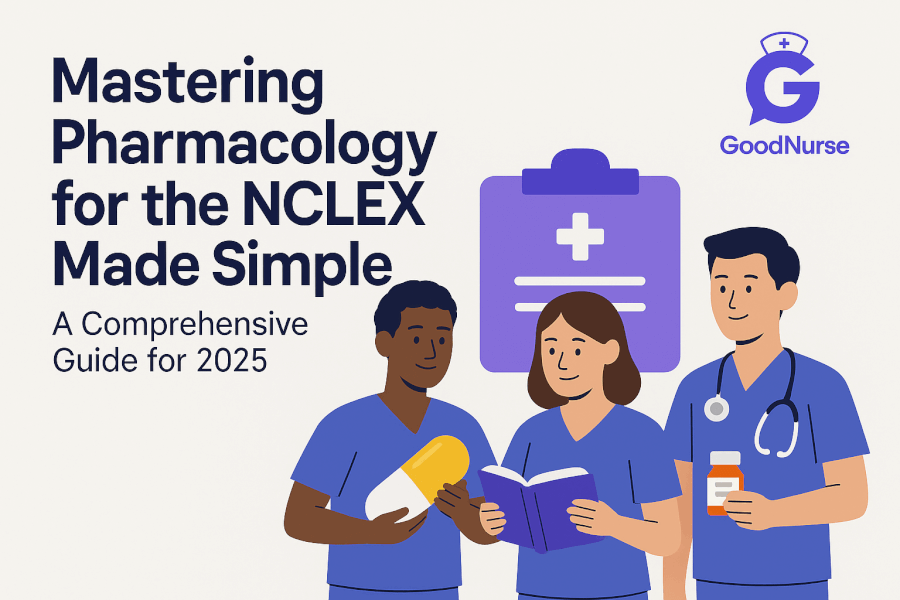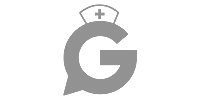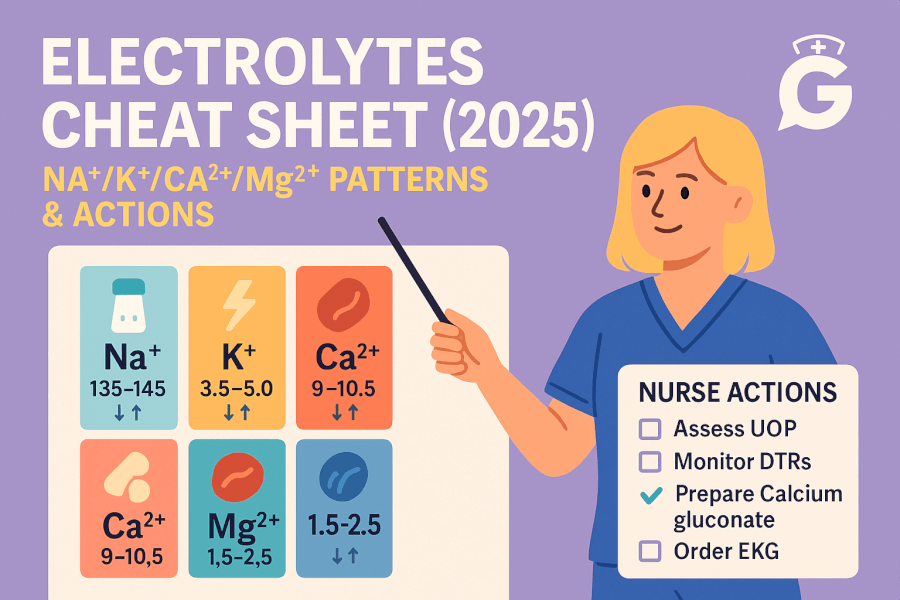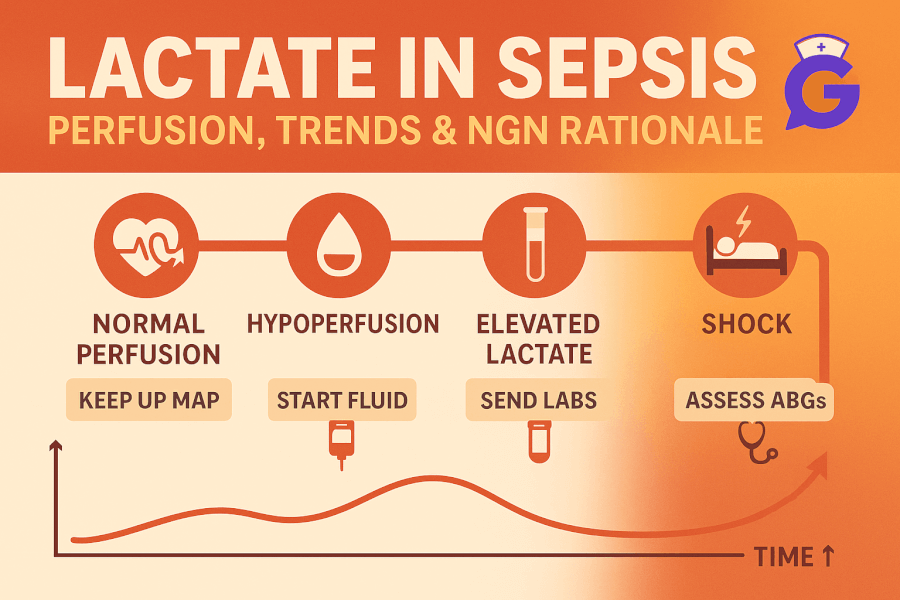I. Introduction: Why Mastering NCLEX Pharmacology Is Crucial for Your Success
Pharmacology isn’t merely another subject to study for the NCLEX—it’s a core component of the exam and of safe nursing practice. The Pharmacological and Parenteral Therapies section accounts for 13–19 % of the NCLEX‑RN test plan and 10–16 % of the NCLEX‑PN. A solid grasp of how medications work and how to administer them safely is therefore essential for passing the exam and for protecting patients. This guide demystifies high‑yield pharmacology concepts, from the basics of drug movement to safe administration, and provides practical study strategies tailored to nursing students.
🎯 Free NCLEX pharmacology quiz!
Test your knowledge after you finish reading.
Many nursing students feel overwhelmed by the volume of drug names, mechanisms and calculations. By breaking complex topics into manageable sections, this guide helps you build a foundational understanding of pharmacology that will serve you throughout your career. We’ll cover the fundamental principles of pharmacokinetics and pharmacodynamics, review essential drug calculations, examine high‑yield medication classes and safety frameworks, and share effective study strategies.
II. The Building Blocks: Core Pharmacological Principles Explained
A. Pharmacokinetics: What the Body Does to the Drug
Pharmacokinetics is the study of a drug’s journey through the body. It includes four stages—absorption, distribution, metabolism and excretion (ADME): Absorption occurs when the medication enters the body and moves into the bloodstream, distribution is its movement throughout tissues, metabolism is the body’s breakdown of the drug (often in the liver) and excretion is elimination via urine or feces. Understanding ADME helps you predict onset, peak and duration as well as risks of accumulation or toxicity.
B. Pharmacodynamics: What the Drug Does to the Body
Pharmacodynamics focuses on a drug’s effects at its target sites. It examines how drugs bind to receptors, ion channels or enzymes and how these interactions produce therapeutic or adverse effects. In practice, pharmacokinetics and pharmacodynamics are intertwined: a drug’s movement influences how much reaches the receptor, while receptor binding determines its clinical effect. Recognizing both processes is vital for selecting appropriate medications and monitoring efficacy.
C. Pharmacogenetics and Patient Variability
Individual genetics can alter drug responses. Pharmacogenetics studies how genetic variations affect drug metabolism and receptor interactions. For example, certain patients metabolise medications slower or faster due to differences in liver enzymes, which can lead to subtherapeutic levels or toxicity. Nurses should be aware of these variations and monitor for unexpected responses, especially when patients report unusual side effects.
III. Safe Medication Administration: Rights and Responsibilities
A. The Five Rights of Medication Administration
Nurses serve as the final safety checkpoint before medication reaches a patient. During training, nurses learn the five rights of medication administration: right patient, right drug, right dose, right route and right time: Verifying each right—including confirming the patient’s identity, double‑checking the drug name, calculating the proper dose, ensuring the correct route (oral, IV, IM, topical) and giving it at the prescribed time—helps prevent errors.
B. Beyond the Five Rights: Additional Considerations
Although the five rights provide a foundation, comprehensive medication safety also requires checking allergies, reviewing drug interactions, monitoring therapeutic levels and educating patients. For instance, some medications require slow infusion rates to prevent adverse reactions, and others demand frequent monitoring of laboratory values (e.g., vancomycin trough levels). Always consult institutional policies and evidence‑based guidelines when administering high‑risk drugs.
IV. Demystifying Drug Dosage Calculations
A. Basic Dosage Formulas
Accurate dosing prevents under‑ and overdosing. Key formulas include:
- Dose = (Desired Dose ÷ Stock Strength) × Volume – used to calculate how much liquid medication to give. For example, if a drug order is for 250 mg and you have a vial labeled 500 mg in 2 mL, the dose is (250 ÷ 500) × 2 = 1 mL.
- Flow Rate (mL/hr) = Total Volume ÷ Time (hr) – calculates IV infusion rates. For instance, 1 L of normal saline over 8 hours: 1,000 mL ÷ 8 hr = 125 mL/hr.
- Weight‑based dosing: multiply the ordered dose per kilogram by the patient’s weight in kilograms. Always ensure conversions between pounds and kilograms are accurate (1 kg = 2.2 lb).
B. Tips for Mastering Calculations
Use dimensional analysis or ratio‑proportion methods consistently, write out units to avoid errors, and double‑check calculations with a colleague or calculator. Many nursing programs and employers require competency testing for dosage calculations; practicing these formulas regularly builds confidence.
V. High‑Yield Medication Classes and Nursing Considerations
A. Cardiovascular Drugs (e.g., Beta‑Blockers, ACE Inhibitors, Calcium Channel Blockers)
Understand indications, mechanisms and common side effects: beta‑blockers (end in ‑lol) reduce heart rate and blood pressure; monitor for bradycardia and fatigue. ACE inhibitors (end in ‑pril) lower blood pressure; watch for cough and hyperkalemia. Calcium channel blockers (e.g., amlodipine) cause vasodilation; be alert for hypotension and edema. Cross‑reference our in‑depth article on NCLEX Pharmacology Made Simple: Essential Review of Drugs, Calculations, and Key Concepts Part 3.
B. Antibiotics and Antimicrobials
Classify antibiotics by mechanism (e.g., penicillins inhibit cell wall synthesis, macrolides inhibit protein synthesis). Monitor for allergic reactions, superinfections and nephrotoxicity. For deeper coverage of high‑yield antimicrobial classes, see NCLEX Pharmacology Made Simple: Mastering Antibiotics and Antimicrobials Part 2.
C. Endocrine and Hormonal Medications
Drugs like insulin, oral hypoglycemics (metformin), thyroid replacements (levothyroxine) and corticosteroids require vigilant monitoring. For more on endocrine medications and nursing considerations, refer to NCLEX Pharmacology Made Simple: Essential Review of Drugs, Calculations, and Key Concepts Part 3.
D. Central Nervous System Agents
Pain medications (opioids) and sedatives can depress respiration and consciousness—always count respirations before administration. Anticonvulsants (e.g., phenytoin) require therapeutic drug level monitoring. Review patient education on avoiding alcohol and monitoring for sedation.
VI. Study Strategies and Resources
A. Use Mnemonics and Memory Aids
Create mnemonics to remember drug endings and side effects (e.g., “LOL” for beta‑blockers, “PRIL” for ACE inhibitors, “SARTAN” for ARBs). Visual learners can draw charts or concept maps to organise drug classes.
B. Practice with NCLEX‑Style Questions
Repeated exposure to pharmacology questions improves recall and test readiness. Use question banks and practice quizzes that provide rationales. GoodNurse’s NCLEX practice question bank offers adaptive quizzes tailored to your weak areas.
C. Integrate Pharmacology with Patient Scenarios
Apply drug knowledge to clinical scenarios—consider how medications affect patients with comorbidities (e.g., renal impairment), or how drug interactions might alter outcomes. Practice care plans and medication cards during clinical rotations.
🚀 Ready to test your pharmacology skills?
Access our complete quiz collection.
VII. Final Thoughts and Additional Resources
Pharmacology can be daunting, but breaking it down into key principles, safety practices and high‑yield drug classes makes it manageable. Remember the ADME framework, respect the five rights of medication administration and practice dosage calculations until they become second nature. For more help, explore these related resources:
- NCLEX Study Tips That Actually Work in 2025. Build a personalised study plan with proven strategies, tools and hacks.
- How to Pass the Next Gen NCLEX (NGN). Understand the new question types and develop a winning test‑taking strategy.
- Endocrine Disorders NCLEX Review. Deep dive into endocrine conditions, management and test‑taking tips.
Mastering pharmacology is a marathon, not a sprint. Use GoodNurse’s comprehensive resources and practice quizzes to reinforce your knowledge and approach the NCLEX with confidence.






